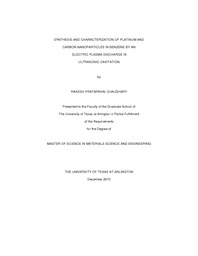
ATTENTION: The works hosted here are being migrated to a new repository that will consolidate resources, improve discoverability, and better show UTA's research impact on the global community. We will update authors as the migration progresses. Please see MavMatrix for more information.
Show simple item record
| dc.contributor.author | Chaudhary, Rakesh Pratapbhai | en_US |
| dc.date.accessioned | 2011-07-14T20:54:36Z | |
| dc.date.available | 2011-07-14T20:54:36Z | |
| dc.date.issued | 2011-07-14 | |
| dc.date.submitted | January 2010 | en_US |
| dc.identifier.other | DISS-11043 | en_US |
| dc.identifier.uri | http://hdl.handle.net/10106/5886 | |
| dc.description.abstract | Nanoparticles are of interest due to the high number of atoms located on the surface. This high surface area is conductive to higher catalytic efficiency than normal seen in bulk metals. Of numerous Nanoparticles catalysts studied, Platinum (Pt) nanoparticles have attracted particular interest due to their superior catalysis for many chemical reactions, especially for fuel cell reactions including hydrogen oxidation and oxygen reduction. Carbon supported Pt nanoparticles are active anode catalysts for fuel cells. In this thesis nano-sized Pt particles have been synthesized by an advanced and cost effective method. Pt nanoparticles embedded in carbon matrix were synthesized by an electric plasma discharge generated in the ultrasonic cavitation field of benzene. Several material characterization techniques such as Transmission electron microscopy (TEM) and X-ray diffraction (XRD) were used to study the particle size and structure of the synthesized nanoparticles. X-ray photoelectron Spectroscopy (XPS) and Energy dispersive X-ray Spectroscopy (EDX) analysis were used to study the chemical composition of the synthesized nanoparticles. Magnetic nanoparticles are of considerable interest owing to their potentials application in magnetic fluids, magnetic recording materials, biomedicine, and other applications. In particular magnetic nanoparticles offer attractive possibilities in biomedicine. The size of magnetic nanoparticles range from few nanometers up to tens of nanometers, which places them at dimensions of biological entity such as a cell, a virus, a protein and a gene. Magnetic nanoparticles can be manipulated using an external magnetic field, which provides applications such as tagging of biomolecules, efficient bioseparation, sensitive biosensing, magnetic resonance imaging and drug delivery. These applications require particles to be biocompatible, stable and biodegradable. Carbon nanoparticles are potentially biocompatible, chemically stable and nontoxic .In this work Graphite nanoparticles and iron doped carbon nanoparticles were synthesized by an electric plasma discharge generated in the ultrasonic cavitation field of benzene. Several material characterization techniques such as High Resolution Transmission Electron Microscopy (HRTEM) and XRD were used to study the particle size and structure of the synthesized nanoparticles.XPS and EDX analysis were used to study the chemical composition of the synthesized nanoparticles. Raman spectroscopy was used to characterize carbon nanoparticles. Magnetic measurement of iron doped carbon and graphite nanoparticles were measured using Vibrating sample magnetometer (VSM). | en_US |
| dc.description.sponsorship | Koymen, Ali R. | en_US |
| dc.language.iso | en | en_US |
| dc.publisher | Materials Science & Engineering | en_US |
| dc.title | Synthesis And Characterization Of Platinum And Carbon Nanoparticle In Benzene By Electric Plasma Discharge In Ultrasonic Cavitation | en_US |
| dc.type | M.S. | en_US |
| dc.contributor.committeeChair | Koymen, Ali R. | en_US |
| dc.degree.department | Materials Science & Engineering | en_US |
| dc.degree.discipline | Materials Science & Engineering | en_US |
| dc.degree.grantor | University of Texas at Arlington | en_US |
| dc.degree.level | masters | en_US |
| dc.degree.name | M.S. | en_US |
Files in this item
- Name:
- CHAUDHARY_uta_2502M_11043.pdf
- Size:
- 3.574Mb
- Format:
- PDF
This item appears in the following Collection(s)
Show simple item record


